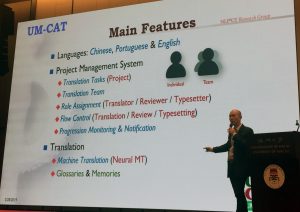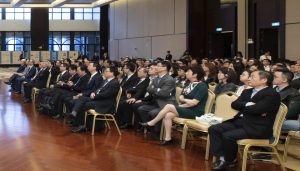The University of Macau (UM) today (28 February) held a ceremony for the signing of a collaborative framework agreement with the Institute of Automation, Chinese Academy of Sciences (CAS-IA), and a joint academic workshop. UM-CAT, the latest machine translation system developed by UM researchers, was presented following the agreement signing ceremony. Using state-of-the-art technologies, this translation system can effectively assist professional translators and their team members in the translation, proofreading and management of translation projects that involve three languages, namely Chinese, English, and Portuguese, thereby enhancing translation efficiency. This system represents a major breakthrough achieved by UM researchers in integrating artificial intelligence technology in the development of machine translation systems. It attracted much interest and attention from conference participants, including professional translators.
UM-CAT was developed by UM’s Natural Language Processing & Portuguese-Chinese Machine Translation Laboratory (NLP2CT). According to Wong Fai, director of the NLP2CT and associate professor in the Faculty of Science and Technology, in addition to producing smart full-text translation with a high degree of accuracy, UM-CAT has various other functions, such as creating industry-specific terminology databases, enabling clear division of labour for large projects, effectively monitoring translation and review progress, and suggesting terms for reference. It is suitable for individuals, government departments and companies that need to handle a large amount of translation projects involving the three languages. Prof Wong explains that UM-CAT has two features that help enhance translation efficiency. First, the multiple built-in functions, such as translation memory, glossary management, collaborative translation, and AI-based prompting, enable the system to show the translations that were translated, suggested, or adopted by different translators for the current user’s reference, in order to ensure consistency and accuracy. Second, the user interface that integrates the various steps of a translation project, from translation to proofreading to typesetting, enables flexible division of labour for different projects, facilitates day-to-day management of complex projects, and allows users to effectively monitor translation progress and view the final product, thereby enhancing team efficiency.
Prof Wong adds that compared to other online translation platforms, UM-CAT has another advantage. It does a better job of translating Macao-specific terminology, including street names, government departments, legal jargon, and other terms commonly used in Macao. The NLP2CT is dedicated to developing and perfecting machine translation systems. So far, it has launched various innovation technologies, including the PCT, a Chinese/Portuguese translation system; the Um2T, an online interactive Chinese/Portuguese machine translation system; and the smart translation platform. Earlier, an English-Chinese machine translation system developed by the lab received the top three prizes as well as the fifth prize at the constraint English-to-Chinese machine translation campaign organised under the 13th China Workshop on Machine Translation.
Source: Communications Office
Media Contact Information:Communications Office, University of Macau
Albee Lei Tel:(853) 88228004Kelvin U Tel:(853) 88224322Email:prs.media@um.edu.mo
UM Website:www.um.edu.mo


